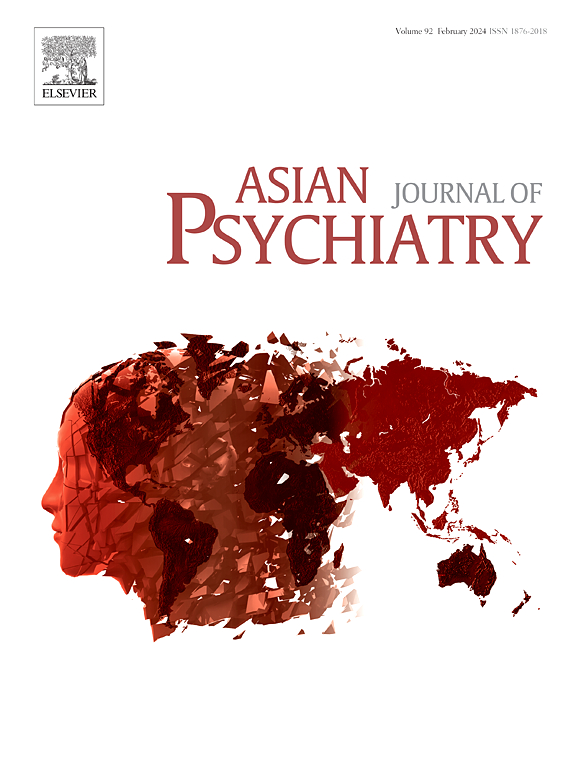精神病缓解患者最小有效剂量的真相或神话:引导性剂量减少试验的意义
IF 4.5
4区 医学
Q1 PSYCHIATRY
引用次数: 0
摘要
目的优化抗精神病药物剂量对患者恢复功能而不增加复发风险至关重要。据报道,治疗急性期或稳定期患者的抗精神病药最低有效剂量(MED)是氯丙嗪当量(CPZE)剂量200 mg/d。对一组接受前瞻性剂量减少的缓解患者进行了评估,以确定低于指定MED的剂量是否仍能提供足够的预防效果。方法96例症状稳定的精神分裂症相关精神障碍患者接受为期2年的剂量递减试验。根据抗精神病药物剂量(CPZE >;200 vs. CPZE≤200 mg/d),我们评估基线和2年随访结束时在临床严重程度、个人社会表现、生活质量、药物满意度和就业状况方面是否存在差异。结果基线时,59例受试者接受CPZE≤ 200 mg/d治疗,37例受试者接受CPZE >; 200 mg/d治疗。在2年的随访中,42名患者成功减少了剂量。在亚组中,剂量从>; 200 mg/d减少到≤ 200 mg/d的13名参与者的临床结果与其基线水平相当;在2年内接受≤ 200 mg/d治疗的患者中,有45例患者的预后明显改善,但这种改善主要是由于其中25例患者在如此低的剂量水平下进一步减少了抗精神病药物。结论维持剂量CPZE≤ 200 mg/d在小样本量队列中较为常见。谨慎的剂量逐渐减少允许一些患者进一步减少抗精神病药物,没有增加复发的风险,并且能够改善他们的功能。本文章由计算机程序翻译,如有差异,请以英文原文为准。
Truth or myth of minimum effective dose for patients with remitted psychosis: Implications from a guided dose reduction trial
Objective
Optimizing antipsychotic dosage is crucial for patients to resume functioning without increased risk of relapse. The reported antipsychotic minimum effective dose (MED) for treatment of either acute phase or stable patients is a chlorpromazine equivalent (CPZE) dose of 200 mg/d. A cohort of remitted patients undergoing prospective dose reduction were evaluated to determine if a dose less than the designated MED could still provide adequate prophylactic effects.
Methods
Ninety-six individuals with schizophrenia-related psychotic disorders whose symptoms were stable with their current medication were eligible for a 2-year dose tapering trial. Divided into two groups according to antipsychotic doses (CPZE > 200 vs. CPZE ≤ 200 mg/d), we evaluated if there were differences in clinical severities, personal social performance, quality of life, medication satisfaction, and employment status between baseline and the end of 2-year follow-up.
Results
At baseline, 59 participants received CPZE ≤ 200 mg/d and 37 participants received CPZE > 200 mg/d. At the 2-year follow-up, 42 patients had successfully reduced their doses. Among subgroups, 13 participants whose doses were reduced from > 200 mg/d to ≤ 200 mg/d had clinical outcomes comparable to their baseline levels; while 45 patients who received ≤ 200 mg/d throughout the 2 years showed significantly better outcomes, such improvements were mainly contributed by 25 of them further reducing antipsychotics at such a low dose level.
Conclusion
Maintenance dose CPZE ≤ 200 mg/d was common in this small sample-sized cohort. Careful dose tapering allowed some patients to reduce antipsychotics further with no increased risk of relapse and were able to improve their functioning.
求助全文
通过发布文献求助,成功后即可免费获取论文全文。
去求助
来源期刊

Asian journal of psychiatry
Medicine-Psychiatry and Mental Health
CiteScore
12.70
自引率
5.30%
发文量
297
审稿时长
35 days
期刊介绍:
The Asian Journal of Psychiatry serves as a comprehensive resource for psychiatrists, mental health clinicians, neurologists, physicians, mental health students, and policymakers. Its goal is to facilitate the exchange of research findings and clinical practices between Asia and the global community. The journal focuses on psychiatric research relevant to Asia, covering preclinical, clinical, service system, and policy development topics. It also highlights the socio-cultural diversity of the region in relation to mental health.
 求助内容:
求助内容: 应助结果提醒方式:
应助结果提醒方式:


